Eating Oxford
The History of Chocolate: from Cacao Pod to Creamy Bar
It’s no coincidence that February is both Heart Health Month and National Chocolate Lovers Month. After all, chocolate has been stimulating hearts and minds, literally, for about 4,000 years.
Once reserved as tribute to gods and royals, chocolate and cocoa now fuel a global industry of $117-$128 billion annually. Agricultural sustainability and fair trade labor practices for cacao production are now a major concern for economists and ethicists focused on improving third-world living conditions and the environment.
Chocolate Facts 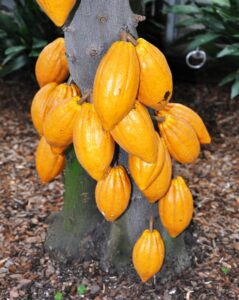 A cocoa tree takes 5-8 years to mature, and they are grown in the shade of banana and mango trees. Each tree is expected to yield about 5 lb of chocolate a year – the beans grow along the trunk of the trees.
A cocoa tree takes 5-8 years to mature, and they are grown in the shade of banana and mango trees. Each tree is expected to yield about 5 lb of chocolate a year – the beans grow along the trunk of the trees.
Milk chocolate: contains at least 10% chocolate liquor (raw chocolate pressed from carob bibs, the center of the bean shells removed after roasting for 2 hours at 250˚F).
Sweet and semi-sweet chocolate are made from 15-35% chocolate liquor plus sugar, cocoa butter and vanilla.
Bittersweet chocolate, often called “baker’s chocolate,” contains 50% chocolate liquor and has a bite (unsweetened).
White chocolate technically is not chocolate: It contains at least 20% cocoa butter, 3.5% milk fat, 14% milk solids, and no more than 55% sugar or other sweeteners, but none of the dark-colored cocoa solids or cocoa liquor, and also none of the stimulants or antioxidants of regular chocolate.
It takes about 400 cacao beans to make one pound of chocolate (450 grams).
U.S. chocolate makers use over 3.5 million pounds of milk daily to make chocolate.
Today, approximately two-thirds of the world’s cocoa is produced from cacao grown in west Africa, and about half of that amount in Cote d’Ivoire, where it is estimated as much as 40% of the labor force has included slave workers.
The average American eats 10-12 pounds of chocolate a year compared to the Swiss, who eat about 21 pounds a year.
The Chocolate Timeline The Mokaya on the Chiapas Pacific coast of Mexico were the first culture known to have used chocolate.
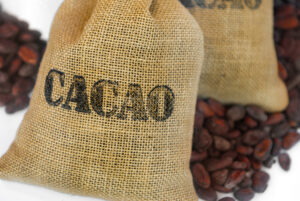 The Olmecs, in what is now the Vera Cruz region of southeastern Mexico, were preparing chocolate beverages in the Early Formative Period (1900-900 BCE). They used it mixed with water, and sometimes with maize and chili for religious rituals or as a medicinal drink.
The Olmecs, in what is now the Vera Cruz region of southeastern Mexico, were preparing chocolate beverages in the Early Formative Period (1900-900 BCE). They used it mixed with water, and sometimes with maize and chili for religious rituals or as a medicinal drink.
Mayans (flourishing in southeastern Mexico, the Yucatan peninsula and Guatemala, 1000 BCE -1542 ACE), and Aztecs (Aztec civilization in the central Mexico Valley, flourishing circa 1325-1521 ACE) also made a frothy, bitter drink from cacao; the Mayan version was hot, the Aztec version was cold.
Cacao plants grew abundantly in the Mayan region. Cacao seeds were used as currency throughout the Mayan empire and later by the Triple Alliance of the Aztecs.
The Spaniards invading Mexico encountered and adapted the terms for the cacao beverage(s), including the Aztecs’ Nahuatl language variations of “xocoatll” (zho-ko-atul, meaning beverage of maize), “xococ” (pronounced sho-coke, meaning sour or bitter) and “atl” (meaning water or drink ), and “chokol” (meaning hot in Yucatec Maya) and “atl” (water); “chicolatl” (Eastern Nahuatl for beaten drink) or “cacaua atl” (meaning drink of cacao).
The Pueblos, who flourished in what is now the American Southwest, imported cacao from Mexico between 900 and 1400 ACE. Unlike their Central American colleagues, the Pueblos used chocolate in a common beverage consumed by all members of their culture.
The Aztecs believed that Quetzacoatl had been condemned by the other gods for sharing chocolate with humans. By 1400, conquered cultures that grew cacao beans were ordered to pay them as a tax or tribute for being ruled by the Aztecs.
Considering it a medicinal aphrodisiac and energy booster, Hernán Cortez in 1528 took Montezuma’s special xocoatl chocolate beverage to the Spanish Royals. Unlike Columbus 30 years earlier, Cortez sweetened his chocolate drink with West Indian sugar before presenting it at Court. This time the Royals took notice.
The Spaniards started a cocoa processing plant in 1580. They kept strict control of chocolate within their empire’s borders.
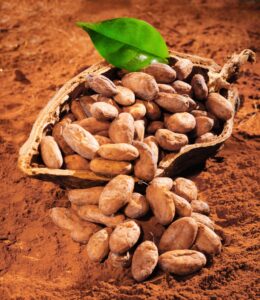 Chocolate was taken to the royal wedding of Anne of Austria (daughter of Spain’s King Phillip III) to King Louis XIII of France in 1615, and soon became popular among the ruling classes throughout Europe and England.
Chocolate was taken to the royal wedding of Anne of Austria (daughter of Spain’s King Phillip III) to King Louis XIII of France in 1615, and soon became popular among the ruling classes throughout Europe and England.
The English, Dutch and French established their own cacao plantations in Southeast Asia and Africa, run between the early 17th and late 19th centuries with slave labor.
Dr. James Baker and John Hannon opened the first American chocolate factory at a water-powered mill in Dorchester, Massachusetts, in 1765, selling hard cakes of chocolate that colonists ground up to make hot chocolate.
American colonials’ chocolate was imported from the West Indies and became a patriotic consumable after the British Townshend Acts of 1767 levied taxes on shipments of tea to the colonies.
American soldiers used cacao as food during the American Revolutionary War; during the War of 1812, Baker’s Chocolate had to be close for 2 years due to the seaport blockades by the British.
In 1815, Dutch chemist Coenraad Van Houten developed a process to reduce the bitterness by adding alkaline salts to chocolate.
In 1828 Van Houten created a press to remove cacao butter from the chocolate liquor, enabling the chocolatier to improve flavor consistency.
Joseph Fry learned how to add back melted cacao butter to render chocolate moldable; Fry & Sons introduced the first solid eating chocolate in England in 1847, but it had a bitter taste.
In 1849, Domingo Ghirardelli began selling chocolate to Gold Rush miners, opening a factory in San Francisco in 1852; it is American’s longest continuously operating chocolate manufacturer.
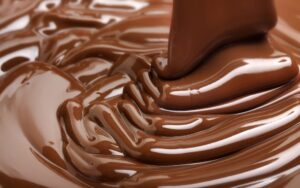 In 1852, Baker’s Chocolate employee Samuel German invented a “sweet chocolate” that had a higher sugar content than previous baking chocolates; it was named “German’s Sweet Chocolate”; German Chocolate Cake is named after Samuel German’s chocolate.
In 1852, Baker’s Chocolate employee Samuel German invented a “sweet chocolate” that had a higher sugar content than previous baking chocolates; it was named “German’s Sweet Chocolate”; German Chocolate Cake is named after Samuel German’s chocolate.
Between 1874 and 1875, Swiss chocolatier Daniel Peter combined powdered milk (a process developed by Henri Nestlé) with chocolate liquor to create milk chocolate.
In 1879 Rodolph Lindt invented a “conche” machine to evenly distribute the cocoa butter within the chocolate using oxidation and frictional heat to release acids and volatile chemicals. Length of time conching the chocolate affect(s)ed its flavor, and chocolate bars became a tasty edible.
Milton Hershey visited the 1893 World’s Fair in Chicago and bought equipment to make chocolate coating for his caramels, later producing milk chocolate bars.
Hershey opened a chocolate factory for producing those bars in what is now Hershey, PA, in 1905 – near the dairy farms that provided the milk for the chocolate.
In The Candy Cookbook, published in 1917, Alice Bradley featured the first-ever chapter dedicated solely to chocolate recipes.
The U.S. Quartermaster Corps shipped 20-40-pound blocks of chocolate to Army bases in Europe during World War I; the blocks were chopped into bars for use by the soldiers
In 1937, Ruth Graves Wakefield, owner of the Toll House Inn in Whitman, MA, sold her chocolate chips idea and cookie recipe to Nestlé in exchange for a lifetime supply of chocolate.
M&M’s were invented in 1941 as an energy-boosting ration for World War II soldiers; the hard candy shell prevented the chocolate from melting.
The U.S. government still includes chocolate in rations to troops, and chocolate has gone into space with U.S. astronauts.
For a delicious chocolate truffle recipe, visit On Cooking Southern.
Laurie Triplette is a writer, historian and accredited appraiser of fine arts, dedicated to preserving Southern culture and foodways. Author of the award-winning community family cookbook GIMME SOME SUGAR, DARLIN’, and editor of ZEBRA TALES (Tailgating Recipes from the Ladies of the NFLRA), Triplette is a member of the Association of Food Journalists, Southern Foodways Alliance and the Southern Food and Beverage Museum. Check out the GIMME SOME SUGAR, DARLIN’ website and follow Laurie’s food adventures on Facebook and Twitter.



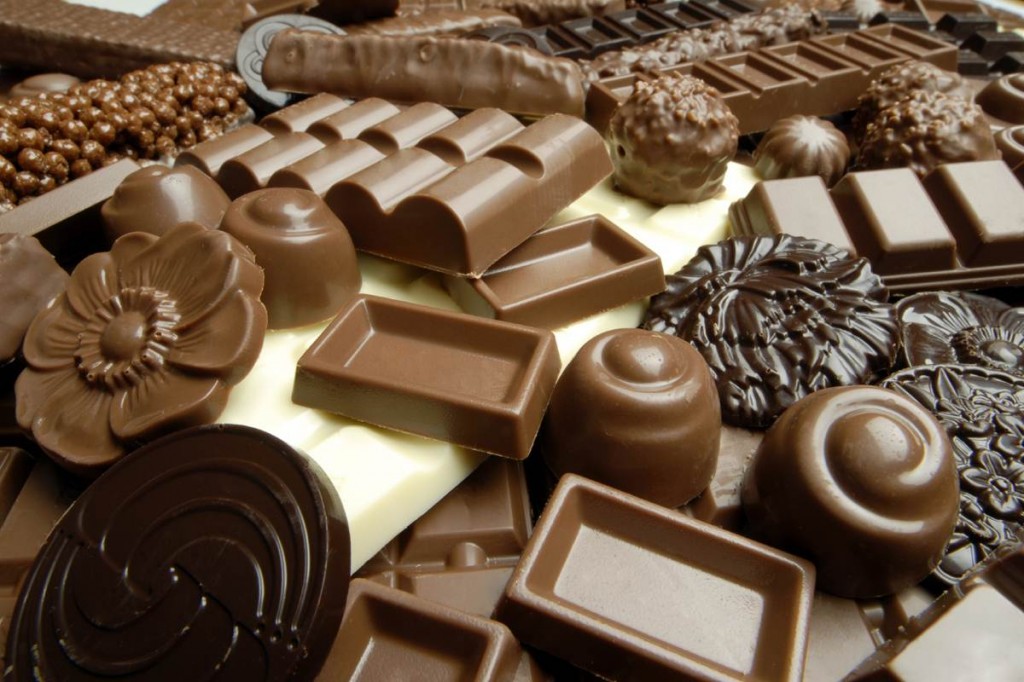














Jocelyn
May 17, 2015 at 12:46 pm
Right away I am going to do my breakfast, once having my breakfast coming again to
read further news.
Panthers Jersey
February 3, 2016 at 12:53 am
Panthers Jersey Pro Shop. Buy full selection of cheap arolina panthers
Nike jerseys of men,women and kids. Recommend the hot
cam newton shirt clothing and more wholesale nfl jerseys in black,blue,white for game,elite.
94Evelyn
July 30, 2017 at 5:56 pm
Hello blogger, i must say you have very interesting content here.
Your page can go viral. You need initial traffic boost only.
How to get it? Search for; Mertiso’s tips go viral